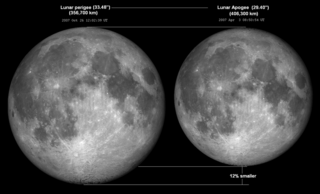- Lunar distance (astronomy)
-
This article is about the average distance from the Earth to the Moon. For its other use in navigation, see Lunar distance (navigation).
In astronomy, a lunar distance (LD) is a measurement of the distance from the Earth to the Moon. The average distance from Earth to the Moon is 384,400 kilometers (238,855 mi)[1]. The actual distance varies over the course of the orbit of the moon.
High-precision measurements of the lunar distance are made by measuring the time taken for light to travel between LIDAR stations on Earth and retroreflectors placed on the Moon.
The Moon is spiraling away from Earth at an average rate of 3.8 cm per year, as detected by the Lunar Laser Ranging Experiment.[2][3][4] By coincidence, the diameter of corner cubes in retroreflectors on the Moon is also 3.8 cm.[5][6]
The first person to measure the distance to the Moon was the 2nd-century-BCE astronomer and geographer Hipparchus, who used simple trigonometry. He was approximately 26,000 km off the actual distance, an error of about 6.8%.
The NASA Near Earth Object Catalog includes the distances of asteroids and comets measured in Lunar Distances.[7]
See also
References
- ^ NASA Staff (10 May 2011). ""Solar System Exploration - Earth's Moon: Facts & Figures". NASA. http://solarsystem.nasa.gov/planets/profile.cfm?Display=Facts&Object=Moon. Retrieved 2011-11-06.
- ^ http://curious.astro.cornell.edu/question.php?number=124 Is the Moon moving away from the Earth?
- ^ C.D. Murray & S.F. Dermott (1999). Solar System Dynamics. Cambridge University Press. p. 184.
- ^ Dickinson, Terence (1993). From the Big Bang to Planet X. Camden East, Ontario: Camden House. pp. 79–81. ISBN 0-921820-71-2.
- ^ http://eclipse.gsfc.nasa.gov/SEhelp/ApolloLaser.html
- ^ http://www.physics.ucsd.edu/~tmurphy/apollo/lrrr.html
- ^ NEO Earth Close Approaches
Categories:- Orbit of the Moon
- Moon stubs
Wikimedia Foundation. 2010.

